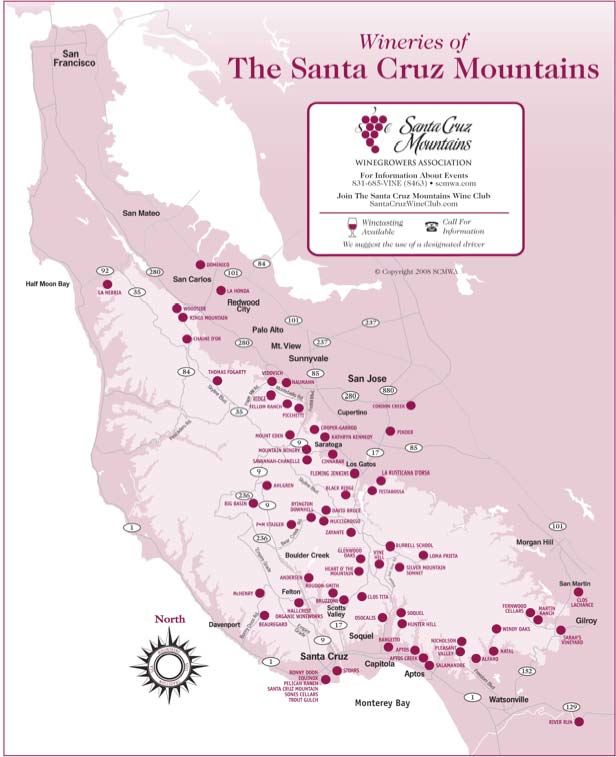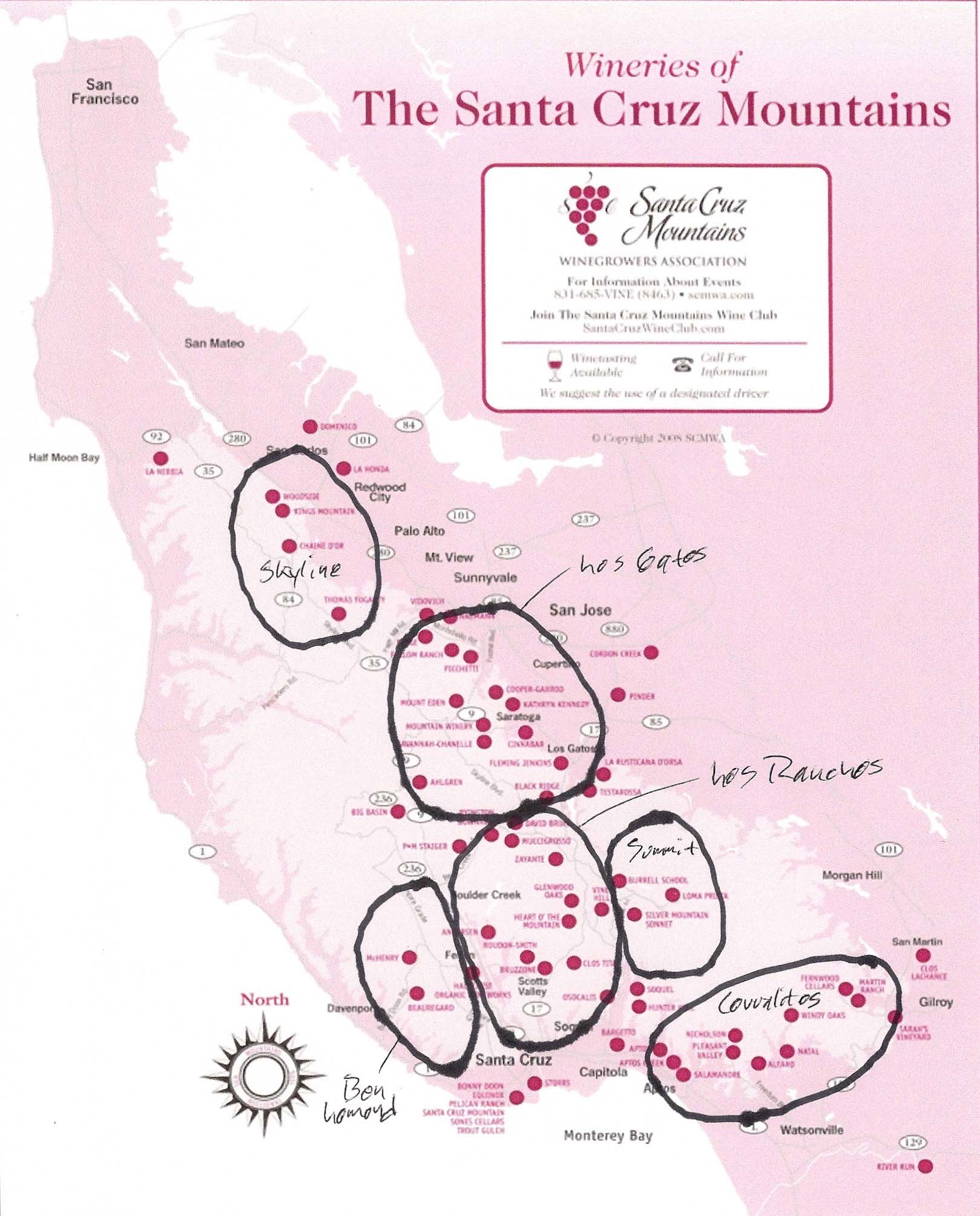Cruzin’ the Santa Cruz Mountains
I returned yesterday from a week long sojourn in the Santa Cruz Mountains. David and Wendy Lloyd, noted
Australian vintners of Pinot Noir (Eldredge Estate in the Mornington Peninsula), wanted to explore the region so
I took them an a journey to many of the top wineries in the area. It is not easy to get your arms around the
region, for it spreads over 380,000 acres in three counties: Santa Cruz County to the West, Santa Clara County
to the East, and San Mateo County to the North. It takes nearly two hours to drive from the northern end at
Half Moon Bay to the southern end at Mount Madonna north of Gilroy. The wineries are often tucked into
nooks and crannies in the mountainous terrain, hidden from view by towering redwood trees, and often at the
end of one lane and circuitous roads. The map provided by the Santa Cruz Mountains Winegrowers
Association does not show specific locations of the wineries. County regulations prohibiting signage to the
wineries, GPS systems are unreliable in many areas, and cell phones can be worthless. The resulting
challenges involved in navigating to wineries are offset by the beautiful landscape and lack of traffic. The Santa
Cruz Mountains is one of the few remaining wine regions where you will never see a limousine and tasting
room staffs are appreciative of your efforts to seek them out.
The Santa Cruz Mountains American Viticultural Appellation (AVA) was federally approved in 1981 and was one
of the first AVAs to be defined by geophysical, altitudinal and climatic factors. The east and west boundaries
are defined by elevation, including mountainous land above 400 feet on the western side, and from 400 to 800
feet on the eastern side. The squiggly outline of the Santa Cruz Mountains AVA reflects the fog line that
surrounds the mountains (see map page 2).
Winegrowing in the Santa Cruz Mountains goes back to at least the 1860s when George Jarvis planted vines in
the Vine Hill area of Santa Cruz County. By the late 1880s, the region had 38, most small wineries. There
were 1,600 planted acres by 1905, with vineyards concentrated in the Felton, Bonny Doon, Vine Hill, Ben
Lomond and Boulder Creek areas on the western side of the Santa Cruz Mountains. Phylloxera did not find its
way easily into the Santa Cruz Mountains, and most of the vines were healthy until Prohibition. After Repeal,
the Italians opened several small wineries, and one, Bargetto, is still in production and is Santa Cruz’s oldest.
On the eastern side of the Santa Cruz Mountains, Charles LeFranc pioneered commercial winegrowing. He
planted his New Almaden Vineyards in 1858. Leland Stanford was a noted winegrower as well, with 350 acres
near Mission San Jose and later 158 acres in the Menlo Park area of San Mateo County. Agoston Haraszthy
planted vineyards between 1853 and 1856 at Crystal Springs Reservoir in San Mateo County. In 1878, Paul
Masson came to San Jose from the Burgundy area of France. He developed a vineyard with cuttings from his
friend, Burgundian Louis Latour, and started a winery in the Santa Cruz Mountains adjacent Mount Eden.
Martin Ray became a protege of Paul Masson and just after Repeal purchased the Paul Masson Champagne
Company from Masson. In 1942, Ray sold the Paul Masson property and moved up the hill, planting the first
vineyard at Mount Eden to Pinot Noir and Chardonnay (Cabernet was added in the 1950s). He named his
estate “Martin Ray,” and became the first boutique Pinot Noir winery and the first to produce a 100% Pinot Noir
varietal wine in California making the Santa Cruz Mountains the birthplace of Pinot Noir in North America.
Martin Ray’s years on Mount Eden are recorded in a book written by his widow, titled, Vineyards in the Sky.
Ray eventually sold Mount Eden to a group of investors who launched the Mount Eden brand in 1972. Today,
Mount Eden is owned by winemaker Jeffrey Patterson who has been at the winery since 1981.
Another iconic figure in the Santa Cruz Mountains was David Bruce, M.D.. According to interviews conducted
by Carole Hicke in 2001 (The David Bruce Winery: Experimentation, Dedication, and Success), Bruce was
attending Stanford Medical School when he had his wine epiphany: a bottle of Richebourg that cost him $7.50.
He planted his vineyard in the Santa Cruz Mountains in 1961 and the David Bruce Winery became bonded


in 1964. For twenty-five years he practiced dermatology and made wine
simultaneously. He was one of twelve California wineries to participate in the
1976 Judgment of Paris in which California wines outscored the French in
blind tastings. Bruce was an innovator with many firsts attributed to him
including a California Blanc de Noir, a white wine from Zinfandel grapes, late
harvest wines, malolactic fermentation for white wines, and use of whole berry
fermentation for red wines. He was also an early importer of French oak.
Bruce was a proponent of punch downs by foot, extensive skin contact, and
small French oak barrel fermentation. Bruce made his first commercial Pinot
Noir in 1966. His early trials with Pinot Noir were marked by hits and misses,
with Brettanomyces causing problems in a number of his early wines.
Eventually, he overcome his shortcomings and produced Pinot Noirs that
brought considerable acclaim.
Today, over 800 acres are planted to Pinot Noir in the appellation, most of which are 1 to 20-acre plantings on
moderately steep hillsides on the western mountain ridges above Monterey Bay and the fog line. Beauregard
Vineyards, the largest grower, manages about 60 acres of Pinot Noir. Located at elevations of 400 to 2,600
feet, most vineyards are exposed to warm days, cool nights, coastal fog in the mornings, and soft marine
breezes in the afternoons. There are about 90 wineries in the Santa Cruz Mountain AVA, over half of which
produce Pinot Noir. Because of the limited vineyard acreage, many Santa Cruz Mountains wineries source
grapes from outside the appellation. However, it is the Santa Cruz Mountain fruit that is most prized and that
produces the distinctive mountain-grown Pinot Noirs that have made the region famous.
The soils are varied throughout the appellation, and include decomposed rock, clay, loam and limestone. The
overriding effect in most areas is a fresh, mineral character and an inviting acidity in the wines. Although the
soil type is not uniform, the ocean fog influence is consistent and ties the appellation together. The Pinot Noir
vineyards in the Santa Cruz Mountains have been grouped into six sub-regions through extensive tastings
conducted by Appellation America and the efforts of Mary Lindsay, President of the Viticulture Association of
the Santa Cruz Mountains, and Prudy Foxx, a well-known viticulturist in the Santa Cruz Mountains who
consults on and manages many vineyards in the region (refer to map on page 4 for the proposed sub-regions).
The subregions include Skyline, Summit Road, Coastal Foothills, Ben Lomond Mountain, Saratoga/Los Gatos,
and Corralitos/Pleasant Valley. Each of the sub-regions have different climatic influences and the wines seem
to have distinctive aromatic and flavor profiles. Listen to this year’s Pinot Paradise Technical Seminar which
includes introductory remarks on the Santa Cruz Mountains by Jim Schultze of Windy Oaks Vineyards &
Winery, a talk on the contrasts between Burgundy and the Santa Cruz Mountains by Joe Miller, PhD, University
of California at Santa Cruz, and a discussion of the newly identified subregions of the Santa Cruz Mountains by
Clark Smith, Director of Appellation Tastings at Appellation America: “Pinot Paradise 3-27-09” 
The quality of the Pinot Noir grapes grown in the Santa Cruz Mountains appellation is unquestioned, but the
challenges in growing wine in this harsh mountainous terrain are numerous. Historically, grapes ripened in only
three out of every ten vintages and the wines were often described as rustic, chunky and tannic. Irrigation
water is very limited or nonexistent, birds (all vineyards must be netted), deer (all vineyards must be fenced)
and gophers are every-present, top soil is poor in many sites, skilled labor is hard to find, and disease
pressure, particularly downy mildew, powdery mildew and botrytis is ever-present. Modern viticultural practices
including control of mildew, proper trellising, and canopy management have been instituted in the last several
years by very experienced vineyard consultants including Prudy Foxx and Greg Stokes. The result has been a
noticeable trend toward dependable yields, although still small, and increasing quality of grapes, resulting in
wines that consistently exemplify the unique terroir of the region. A small and determined cadre of
winegrowers and winemakers have developed a modern style of Pinot Noir from the Santa Cruz Mountains
offering lovely aromatics, luscious red and dark fruit flavors, easily approachable tannins, lively acidity, all
packaged in a medium-bodied style so juicy you can “nibble” at them. The region still has its eccentric and
Bohemian folks who favor the other crop you can smoke rather than the one you can drink and disdain visitors,
but the wine populace is more than welcoming.
In the pages to follow, I will give you a run down on the wineries I visited and the wines I tasted. In addition, I
tasted several Santa Cruz Mountains Pinot Noirs at home in my usual setting.





